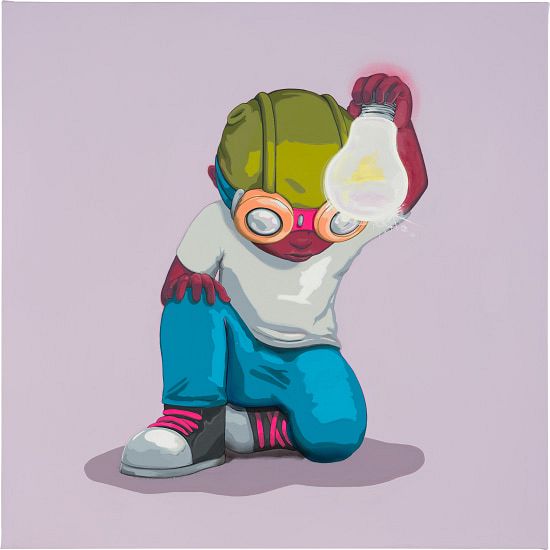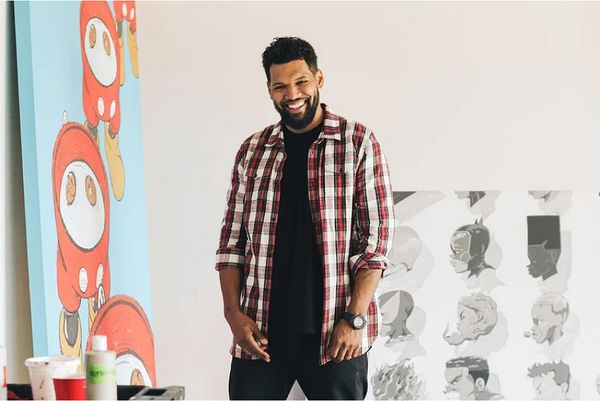Hebru Brantley is best known for his unique approach to Afrofuturism. His narrative-driven work revolves around his conceptualized iconic characters Flyboy and Lil Mama. Influenced by the AfriCOBRA movement of 1960s and ‘70s Chicago — as well as comic books and animation — Brantley utilizes these characters to address complex ideas around nostalgia, the mental psyche, power and hope.
In this conversation with Derek Collins, dean of the faculty of arts at the University of Hong Kong, Brantley discusses his work, influences, and growing commercial popularity.
DEREK COLLINS: You've been inspired very much by the '70s, '80s scene — Basquiat, Warhol, Keith Haring. Tell me about Basquiat. What is it about Basquiat that inspires you?
HEBRU BRANTLEY: With an artist like Basquiat, what he represents for young boys, young boys of the culture, young African-Americans and boys of color, it's that sort of optimistic view of “I can do that.” It's the arriving at Basquiat to then be your intro to the rest of the high art and fine art world, as he arrived at Picasso sort of the same way.
You look at these drawings and these paintings that he's created over his career — which was a short one — and they feel childlike, they feel very youthful. But underneath that, there's a great deal of complexity, and I think that naturally as a novice artist, you kind of arrive at the childlike sort of feeling and an aesthetic, and that brings you in. That was kind of it for me.
I was a huge comic book and cartoon kid, and as a way of my mother trying to divert my attention from the hyper-obsessive nature that I have of diving so deep into those things — in the comic book mythologies and all that stuff — she wanted me to explore other avenues of art. At the time I had no real connection with fine art, and Warhol, Haring, guys like that were ways in for me. Seeing Basquiat do the same thing, I was kind of hooked. It was just that bad.
It was appealing to a young person because when you're so young, your voice is so small in this big world, and within that subculture, you're able to communicate your language and your voice to your peers.
DC: What led you to street art?
HB: It was a lot of the guys from the AfriCOBRA movement. It was Basquiat. It was the early phases and stages of hip-hop culture, graffiti culture. It was sexy. It was appealing to a young person because when you're so young, your voice is so small in this big world, and within that subculture, you're able to communicate your language and your voice to your peers. It's almost like campaigning, tagging your name on the walls and so forth — that was really appealing.
When you travel to the South Side of Chicago, a lot of those murals are still alive and well. They're very well-respected in that community, and it's weird because that's a community that's gone through its ups and downs, its trials and tribulations, and for that art to remain a constant, almost a landmark, is a testament to those artists and what they were able to do.

Hebru Brantley, The Ultra Lumen Pt. 1, 2021.
Price upon request.
DC: When do you get interested in African-American history and start thinking about that, because Flyboy seems to come out of a real interest in the Tuskegee Airmen in particular, so how do those things come together?
HB: It came out of an understanding, at a certain point, of history, more importantly of Black history, the Black body and then also the portrayal of the Black body within different mediums. I think that I got really attracted to the satirical imagery of Blacks in animation and film as collectibles.
DC: That’s blackface, all that stuff.
HB: Yes. As I got older and grew to understand what that was, I felt like within that level of appropriation, there was a power in which those images held and a place in which they hold true to me and my upbringing. But to further explore those notions, that's kind of where it started. It was like looking at the canon of animation since the dawn of that medium and how they treated and talked about African-Americans and the Black body, and wanting to do certain things and associate or sort of reappropriate these images to say and do what I needed to say.
DC: You've moved into lots of commercial products and other things. You've done lots of deals with merchandisers and some major athletics wear companies — Nike, Adidas, the list goes on. What's your view of how this grows?
HB: I'll step back for a second and just say that the art world comes with its own set of unwritten rules, and it takes defiant ones to break those rules. I've had so many collectors, so many gallerists, curators, et cetera, sort of stick their nose up at that approach because it doesn't follow a certain set of guidelines or rules. But I just feel like rules are meant to be broken. Things are always meant to change and evolve.
I look at some of the masters. Warhol was the godfather of pop. He was the godfather of additions and things of that nature, broke all the rules and still only engaged at a certain level. It wasn't until he passed when people started licensing his images to put on doormats or cup holders or whatever. For me it's like no, I want the flowers while I'm still alive to smell them. I want to be able to engage with all audiences because to me, that's a mark of success.
Why limit it to the art world and these collectors, these people that effectively are buying cool? I'm not tearing down one to raise up the other, but it's just that I want people that like and appreciate the things that I do to be able to participate in those things.
Phillips X in collaboration with Bloom Galerie is presenting Solus by Hebru Brantley, a virtual private selling exhibition dedicated to the acclaimed Chicago artist. View the pieces in our virtual gallery here.
